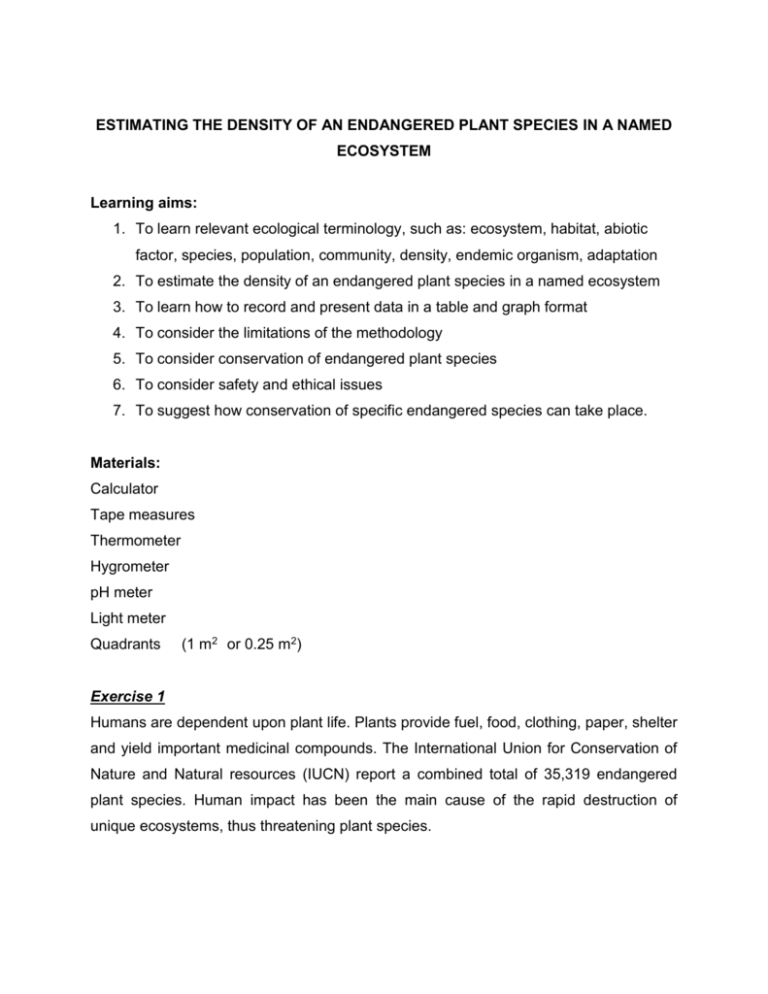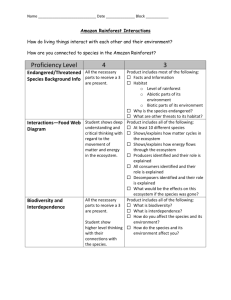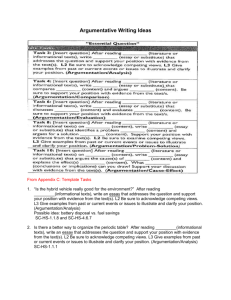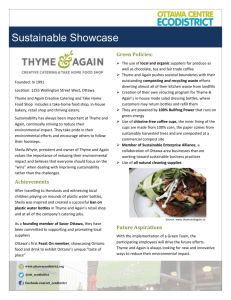Activity 1.1
advertisement

ESTIMATING THE DENSITY OF AN ENDANGERED PLANT SPECIES IN A NAMED ECOSYSTEM Learning aims: 1. To learn relevant ecological terminology, such as: ecosystem, habitat, abiotic factor, species, population, community, density, endemic organism, adaptation 2. To estimate the density of an endangered plant species in a named ecosystem 3. To learn how to record and present data in a table and graph format 4. To consider the limitations of the methodology 5. To consider conservation of endangered plant species 6. To consider safety and ethical issues 7. To suggest how conservation of specific endangered species can take place. Materials: Calculator Tape measures Thermometer Hygrometer pH meter Light meter Quadrants (1 m2 or 0.25 m2) Exercise 1 Humans are dependent upon plant life. Plants provide fuel, food, clothing, paper, shelter and yield important medicinal compounds. The International Union for Conservation of Nature and Natural resources (IUCN) report a combined total of 35,319 endangered plant species. Human impact has been the main cause of the rapid destruction of unique ecosystems, thus threatening plant species. A short passage follows introducing a Cypriot ecosystem: The Cyprus National Park of Athalassa (ecosystem) is the result of afforestation (deliberate planting in an area, which had not recently been a forest land). Thyme is indigenous species in Cyprus, very common to rocky slopes (habitat), disturbed ground and occasionally on sand dunes, in shrub lands and forests. It grows on all types of soils (abiotic factor), as it is a low-demand plant and prevents soil erosion. Thyme has xerophytic (drought-resistant) adaptations. Thyme has been well known since ancient times as a good source of nectar for honey bees, and for its aromatic and medicinal properties. “Thyme is a source of food for bees” (Aristotle Historia animalium). Shepherds also used it as fuel when making the local goat cheese. Such was the demand for thyme that there was a class of traders called “throumpopoulides” (sellers of thyme). A Cypriot amateur beekeeper has kept bee hives in his garden for the last three years, but he has not been able to increase their number. Cyprus has had very little rainfall and it faces desertification. The bee hives have not produced swarms and two beehives have perished. Human impact on the environment has been severe. The bee keeper observed that the number/ population of thyme plants in the Athalassa Park has been declining. It could be that thyme plants are stressed out. 1. Match relevant terms to the descriptions given. (A) Ecosystem or (B) Habitat ...................... is a specific area in a given time that consists of all the living organisms that interact with each other and the abiotic environment. A specific area where a living organism lives is called a ................................................. (C) Population or (D) community A group of individuals in a species is a …………………………………. All organisms in a habitat are described as a ……………………………. (E) Numbers or (F) Density Population size refers to the ……………. in a population. Population ……………. refers to numbers in a given area or volume. 2. State the abiotic factors that may affect an organism in an ecosystem. Possible student answers include the following: pH, temperature, light intensity, moisture, slope, wind, minerals in the soil ………….. Based on the results of any similar evaluation, the teacher will then design activities or classroom discussion for clarifying or introducing the relevant terms, so that students will have clear understanding and orientation for their activities and tasks. Exercise 2 Estimate the density of a specific plant that is present in an ecosystem relative to a named abiotic factor such as temperature. The full practical details of random sampling including apparatus to estimate the density of a specific endangered plant in an ecosystem in relation to an abiotic factor, such as, temperature is provided below. Methodology of random sampling used to estimate the density of thyme plants that are present in a named ecosystem relative to a named abiotic factor that affects plant density. I. State an environmental factor, e.g., TEMPERATURE ………………... II. State the instrument needed to measure the specific abiotic factor, e.g., THERMOMETER … III. Lay out two 10 m tape measures at right angles to each other, in a selected area within the ecosystem that includes the endemic plant of interest, to create an area of 100 m2 IV. Generate ten random number coordinates using a calculator. If there are no calculators, place numbers 1-10 in a bag and pick randomly one number, which will correspond to the X axis coordinate, replace and repeat to select the Y axis coordinate V. Select a quadrant of an appropriate size………………… (e.g., 1m X 1m) …………………. VI. Place the quadrant at the intersection of each pair of the coordinates ……………… VII. Record all the other environmental measurements including the light intensity, using a light meter, the pH of the soil using a pH meter, and the % of moisture using a hygrometer. Why are these measurements needed? Consider the limitations of their experiment. Note: Limitations in an experimental investigation are factors that they cannot control, no matter what they do. VIII. IX. Identify the endemic plant under investigation using keys and photographs… Count the number of individual endemic plants present in each quadrant. Exercise 3 TABLE OF RESULTS Quadrant number 1 2 3 … 10 Total number of thyme in 10 quadrants Number of endangered plants (e.g., Thyme plants) in a quadrant of 1 m2 Exercise 4 1. Estimate the mean density of an endangered plant (the mean density equals the average number of endangered plants per m2). 2. If the area under investigation is 10000 m2 calculate the number of, e.g., thyme plants in the ecosystem under investigation? 3. Compare how the same abiotic factor affects the density of two different plants (or the same plant, found in a different ecosystem). 4. Plot a bar chart indicating: Mean density of each plant (Y axis) versus (type of plant X axis). Exercise 5 Consider the limitations of their experiment by indicating whether the statement below is true or false. • Difficult to control all abiotic factors. TRUE OR FALSE • Not all plants are counted due to difficulty in identifying them. TRUE OR FALSE • Area selected may not represent plant density. TRUE OR FALSE • No repetition has been carried out TRUE OR FALSE • There may be seasonal variation in plant distribution TRUE OR FALSE Exercise 6 Consider any safety and ethical issues, when you are inquiring about the named ecosystem that you will be investigating.









